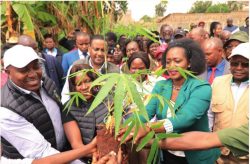 Environment Cabinet Secretary Soipan Tuya (centre) joined by Embu Governor Cecily Mbarire (second left) during a tree planting exercise in the county.
Environment Cabinet Secretary Soipan Tuya (centre) joined by Embu Governor Cecily Mbarire (second left) during a tree planting exercise in the county.
Government calls for participation of all individuals and institutions in the 10-year environment restoration strategy. The government targets to rehabilitate all the country’s degraded landscapes and ecosystems as it implements the 10-year National Landscape and Ecosystem Restoration Strategy, whose anchor initiative is the 15 billion tree planting initiative. The strategy has five key objectives, which include to increase national tree cover by 17.8 per cent by 2032 through targeted interventions on public, community and private lands; improving landscape and ecosystem governance through robust policy, regulatory and institutional frameworks; encouraging private sector investment and develop sustainable financing mechanisms for the restoration of degraded landscapes and strengthening capacity, research, monitoring, evaluation and knowledge management.
Ms. Soipan Tuya, the Cabinet Secretary for Environment, Climate Change and Forestry, said the strategy aims to enhance the ecological integrity of the country while contributing to social and economic transformation.
“Our approach is inclusive, calling for the participation of all Kenyans — from individuals to institutions, public and private sectors, urban and rural areas, and from the young to the old in what we term as the ‘whole-of-society, whole-of government’ approach,” she said as Kenya joined the globe in celebrating World Environment Day on June 5, 2024, whose theme was “Land Restoration desertification and drought resilience”.
Land degradation has manifested in many ways in the country, including through loss of vegetation, increased aridity, scarcity of water sources, growing of shrubs in areas which were predominantly rich in pastures, gullies, thin and stony soils and invasion of intrusive species that lead to food and water insecurity, according to the United Nations Convention to Combat Desertification.
The key drivers of land degradation are “deforestation, overgrazing, poor agricultural activities (overuse of fertilizers, up downhill ploughing), forest fires, poor spatial planning, mining and sand harvesting.” Ms. Tuya noted that Kenya has no choice but to restore the degraded landscapes and ecosystems as the country becomes most vulnerable to climate change. “We are vulnerable to climate change since the key drivers of our economy – agriculture, livestock, tourism, forestry and fisheries, are climate-sensitive. Hence climate change continues to adversely impact Kenya’s socio-economic sectors,” she said. According to her, land restoration holds the key to reversing this tide, as every investment in restoration yields significant returns in terms of improved ecosystem services.
“We believe land restoration involves more than just tree growing; it requires a holistic approach that integrates sustainable land use practices, community engagement and robust policy interventions. In this regard, we recently successfully reviewed the Climate Change Act to mainstream carbon markets as an important climate finance opportunity for Kenya,” she said.
In the ongoing ecosystems restoration campaign, led by Cabinet Secretaries and senior members of the Executive, all MDAs have been allocated sites for tree planting and given targets to achieve. “The new approach, as unveiled by President William Ruto, aims to ensure the full restoration of assigned ecosystems. This involves not only tree planting but also nurturing the young trees and protecting them through fencing to facilitate natural regeneration of the sites,” said Ms. Tuya
